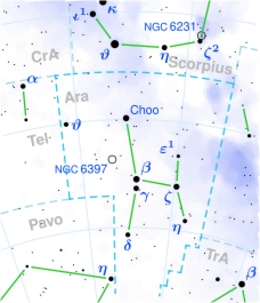Astronomy:Pi Arae
| Observation data Equinox J2000.0]] (ICRS) | |
|---|---|
| Constellation | Ara |
| Right ascension | 17h 38m 05.51512s[1] |
| Declination | –54° 30′ 01.5643″[1] |
| Apparent magnitude (V) | +5.25[2] |
| Characteristics | |
| Spectral type | A5 IV-V[3] |
| B−V color index | +0.20[2] |
| Astrometry | |
| Radial velocity (Rv) | −3.3±3.1[4] km/s |
| Proper motion (μ) | RA: +128.19[1] mas/yr Dec.: +62.16[1] mas/yr |
| Parallax (π) | 46.30 ± 0.19[1] mas |
| Distance | 70.4 ± 0.3 ly (21.60 ± 0.09 pc) |
| Absolute magnitude (MV) | +2.01[5] |
| Details | |
| Mass | 1.73[6] M☉ |
| Radius | 1.90[7] R☉ |
| Luminosity | 13.3[5] L☉ |
| Surface gravity (log g) | 4.36[6] cgs |
| Temperature | 8,215±279[6] K |
| Metallicity [Fe/H] | +0.13[5] dex |
| Rotational velocity (v sin i) | 54.1±0.4[8] km/s |
| Age | 319[6] Myr |
| Other designations | |
| Database references | |
| SIMBAD | data |
Pi Arae, Latinized from π Arae, is the Bayer designation for a star in the southern constellation of Ara. It is faintly visible to the naked eye with an apparent visual magnitude of +5.25.[2] Based upon an annual parallax shift of 46.30 mas as seen from Earth,[1] it is located 70 light years from the Sun. It is most likely moving closer to the Sun with a radial velocity of −3 km/s.[4]
The stellar classification of this star is A5 IV-V,[3] indicating the spectrum displays the hybrid features of both a main sequence and a more evolved subgiant star. Pi Arae is an estimated 319[6] million years old and is spinning with a projected rotational velocity of 54.1 km/s.[8] The star has 1.73[6] times the mass of the Sun and 1.90[7] times the Sun's radius. It is radiating 13.3[5] times the Sun's luminosity from its photosphere at an effective temperature of about 8,215 K.[6]
Pi Arae displays an excess emission of infrared radiation, which may be explained by circumstellar dust.[10] The thermal emission matches a two component model, consisting of an inner disk of warm crystalline silicate dust and an outer colder disk of dirty ice. The inner disk has a temperature of 173 K and is orbiting roughly 9.1 AU from the host star. The outer disk is 77 K and orbits at a distance of about 117.3 AU. The small size of some of the dust grains indicate the inner disk may have formed relatively recently from collisions between orbiting planetesimals.[11]
Located 55 arc minutes to the north of Pi Arae is the globular cluster NGC 6397.[12]
References
- ↑ 1.0 1.1 1.2 1.3 1.4 1.5 van Leeuwen, F. (2007), "Validation of the new Hipparcos reduction", Astronomy and Astrophysics 474 (2): 653–664, doi:10.1051/0004-6361:20078357, Bibcode: 2007A&A...474..653V.
- ↑ 2.0 2.1 2.2 Johnson, H. L. et al. (1966), "UBVRIJKL photometry of the bright stars", Communications of the Lunar and Planetary Laboratory 4 (99): 99, Bibcode: 1966CoLPL...4...99J.
- ↑ 3.0 3.1 Houk, Nancy (1978), Michigan catalogue of two-dimensional spectral types for the HD stars, 1, Ann Arbor: Dept. of Astronomy, University of Michigan, Bibcode: 1975mcts.book.....H.
- ↑ 4.0 4.1 Gontcharov, G. A. (November 2006), "Pulkovo Compilation of Radial Velocities for 35495 Hipparcos stars in a common system", Astronomy Letters 32 (11): 759–771, doi:10.1134/S1063773706110065, Bibcode: 2006AstL...32..759G.
- ↑ 5.0 5.1 5.2 5.3 Anderson, E.; Francis, Ch. (2012), "XHIP: An extended hipparcos compilation", Astronomy Letters 38 (5): 331, doi:10.1134/S1063773712050015, Bibcode: 2012AstL...38..331A.
- ↑ 6.0 6.1 6.2 6.3 6.4 6.5 6.6 David, Trevor J.; Hillenbrand, Lynne A. (2015), "The Ages of Early-Type Stars: Strömgren Photometric Methods Calibrated, Validated, Tested, and Applied to Hosts and Prospective Hosts of Directly Imaged Exoplanets", The Astrophysical Journal 804 (2): 146, doi:10.1088/0004-637X/804/2/146, Bibcode: 2015ApJ...804..146D.
- ↑ 7.0 7.1 Patel, Rahul I. et al. (May 2014), "A Sensitive Identification of Warm Debris Disks in the Solar Neighborhood through Precise Calibration of Saturated WISE Photometry", The Astrophysical Journal Supplement Series 212 (1): 23, doi:10.1088/0067-0049/212/1/10, 10, Bibcode: 2014ApJS..212...10P.
- ↑ 8.0 8.1 Díaz, C. G. et al. (July 2011), "Accurate stellar rotational velocities using the Fourier transform of the cross correlation maximum", Astronomy & Astrophysics 531: A143, doi:10.1051/0004-6361/201016386, Bibcode: 2011A&A...531A.143D.
- ↑ "pi. Ara". SIMBAD. Centre de données astronomiques de Strasbourg. http://simbad.u-strasbg.fr/simbad/sim-basic?Ident=pi.+Ara.
- ↑ Morales, Farisa Y. et al. (April 2011), "Common Warm Dust Temperatures Around Main-sequence Stars", The Astrophysical Journal Letters 730 (2): L29, doi:10.1088/2041-8205/730/2/L29, Bibcode: 2011ApJ...730L..29M, https://authors.library.caltech.edu/24736/1/Morales2011p15446Astrophys_J_Lett.pdf.
- ↑ Morales, F. Y. et al. (October 2013), "Herschel-resolved Outer Belts of Two-belt Debris Disks around A-type Stars: HD 70313, HD 71722, HD 159492, and F-type: HD 104860", The Astrophysical Journal 776 (2): 13, doi:10.1088/0004-637X/776/2/111, 111, Bibcode: 2013ApJ...776..111M.
- ↑ O'Meara, Stephen James (2013), Deep-Sky Companions: Southern Gems, Cambridge University Press, p. 358, ISBN 978-1139851541, Bibcode: 2013dcsg.book.....O, https://books.google.com/books?id=BoIsCgAAQBAJ&pg=PA358.
External links
 |


